Mission Matters #60 – Intellectual Traditions of the Arts & Sciences

This year we are exploring intellectual traditions associated with schools and colleges of the university. This essay is the second of two pieces written by faculty from the Shaheen College of Arts and Sciences. Dr. Steve Spicklemire, director of engineering instruction and associate professor of physics and earth space science, wrote this month’s essay. Dr. Kathleen Hacker wrote Mission Matters #59.
Introduction by Michael G. Cartwright, Vice President for University Mission and Associate Professor of Philosophy & Religion
Our colleague Steve Spicklemire graciously agreed to expand his remarks on “Engineering Among the Arts & Sciences,” which he gave at the 2019 edition of Wisdom’s Feast, hosted by the Shaheen College of Arts and Sciences. As a longtime member of the Shaheen College of Arts and Sciences, Prof. Spicklemire’s observations are trustworthy and insightful. My task is simply to provide some historical context.
First, from the beginning, the faculty of Indiana Central University aspired to offer specialized training alongside courses of study shaped by the liberal arts and scientific disciplines. But the founders sputtered with limited coordination, inadequate provisions, and chronic under-enrollment. Ultimately, their efforts failed to meet external standards. After 1921, the faculty had to settle for offering “standard college” coursework. The founders’ vision of a university with a conservatory, a college of liberal arts and sciences and several “schools” had to be set aside for a time.
Second, this situation began to change after World War II. Under the leadership of President I. Lynd Esch (1945-1970), the undergraduate curriculum in arts & sciences was accredited in 1947. Thereafter, the ICC faculty began to establish cooperative programs, which enabled students to do general education coursework here and do professional track courses at other universities. Engineering was one of these early initiatives (1957), which President Esch dubbed “liberal arts for specialists.” Over the next quarter of a century, these programs worked more or less well for that purpose. However, most students found it difficult to complete the coop engineering degree with Purdue University in a four-year period, and students sometimes had to re-do courses or transfer programs altogether. These collaborations were never flexible enough to meet student needs. So it is not surprising that UIndy faculty and students might seek more workable approaches while finding the balance of general education and pre-professional curricular requirements.
Third, as we have seen growing interest in interdisciplinary teaching and learning in other precincts of the university, the existing provisions for such programs have been subject to criticism from different vantage points. Some faculty point to the existence of pre-professional majors that require a large number of hours as a significant obstacle for sustaining a strong program in the arts & sciences. Others argue that the general education curriculum requirement is too large. And still, other colleagues have pointed to the preoccupation with course configurations based on outdated content coverage frameworks as opposed to newer paradigms “project-based learning.”
This is precisely where the engineering curricula are already proving to be very fruitful.
Prof. Spicklemire’s testimony provides a straightforward account of how the Shaheen College of Arts and Sciences makes it possible to offer the different programs in the engineering curricula of the Annis School, and the ways that the engineering program’s own criteria for assessment and accreditation are integrated with the objectives of a liberal arts education. That doesn’t mean that we won’t continue to have disagreements about the possibilities and limits of interdisciplinarity at UIndy. But in order to engage such arguments most truthfully, we need to pay attention to background agreements that we share. That is precisely what Dr. Spicklemire’s essay does and more. —MGC
Engineering Among the Arts and Sciences
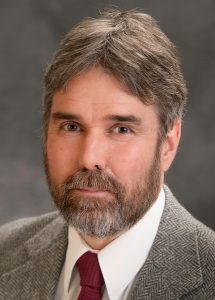 By Steve Spicklemire, Director of Engineering Instruction and Associate Professor of Physics and Earth Space Science
By Steve Spicklemire, Director of Engineering Instruction and Associate Professor of Physics and Earth Space Science
At first glance, it may seem mysterious to find the R.B. Annis School of Engineering (RBASOE) embedded within the Shaheen College of Arts and Sciences. After all, engineering is a professional field, right? According to conventional academic wisdom, this is a very “career-focused” enterprise that wouldn’t ordinarily embrace the values of “interdisciplinarity” and “general education,” as you’d expect most departments and schools that occupy the halls of such a college would.
Part of the solution to this apparent mystery is the vision of the Shaheen College, where interdisciplinarity is truly a core tenet. Interdisciplinarity, as I see it, is the proposition that we can learn, discover, and advance our understanding more by working across disciplines than we can alone, within our disciplinary silos. UIndy is especially well-suited to this kind of vision because we are a close community with an abundance of mutual respect for our colleagues and their work. We are open to the opportunities that interdisciplinarity has to offer. We see our disciplinary diversity as a strength and we find ways to work collaboratively, across disciplines, to explore ideas that would not otherwise be accessible.
Another element of the solution is the unique mission of the RBASOE: to use interdisciplinary education to develop modern engineering leaders who create outstanding solutions. For the School of Engineering, the general education core and the concept of interdisciplinarity are not problems to be overcome, but represent the backbone of our programs, or maybe the “spine”? Right. The DesignSpine! If you’ve not heard of our “DesignSpine,” it’s the framework upon which all our programs are built. The DesignSpine is our answer to the question “What is the essential engineering experience?” The DesignSpine is where students apply everything they are learning, not only the science, math, and engineering courses, but the communication, art, history, philosophy and all the elements of the general education curriculum. It’s an interdisciplinary process that is threaded through our programs.
This is all pretty abstract. Let’s make it a bit more concrete. In the RBASOE we’ve been immersed recently in accreditation work. I know, bleah. But wait, this is relevant! The Accreditation Board for Engineering and Technology (ABET) accredits engineering programs worldwide. We’ve been preparing for ABET accreditation since our first programs began over three years ago. I believe it would be useful to consider a few of the outcomes that ABET expects from engineering programs like ours:
An ability to identify, formulate, and solve complex engineering problems by applying principles of engineering, science, and mathematics
Note that the act of applying principles of science and mathematics, each a cornerstone of the Shaheen College, is a core ABET outcome. The essential act of engineering is to apply our understanding of nature and our ability to reason to design solutions to concrete human problems. Without a deep understanding of the natural world and the tools of mathematics to apply that understanding analytically and logically, engineers would be utterly incapable of producing competitive, high-quality designs.
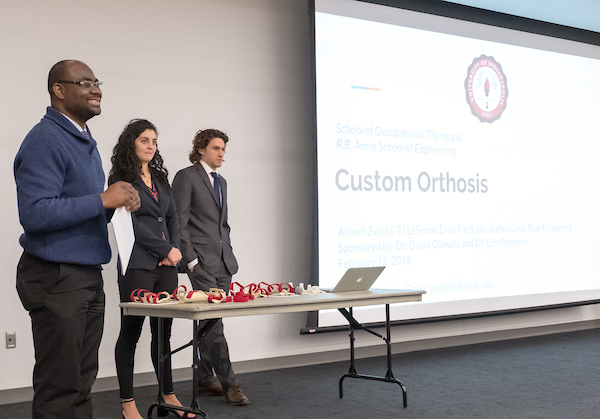
An ability to apply engineering design to produce solutions that meet specified needs with consideration of public health, safety, and welfare, as well as global, cultural, social, environmental, and economic factors
Being able to create technically sound solutions is not sufficient. In order to design outstanding solutions, engineers must understand and take into account all these considerations! These are the domain of the gen-ed core and the focus of the Shaheen College. How can our students gain experience with these issues during their short time at UIndy? This is one of the fundamental intents of the DesignSpine: Students work with external stakeholders on authentic design problems. Issues of safety, welfare, cultural, social, environmental and economic factors inevitably arise as they work through the design process. How much will this design cost to produce? What resources will be required? Is it safe? What effect will it have on the environment? On the manufacturer? On the user? On society? The list of questions is extensive, and answering the questions requires research, experimentation, analysis, and an appreciation of the different places, people, and cultures involved.
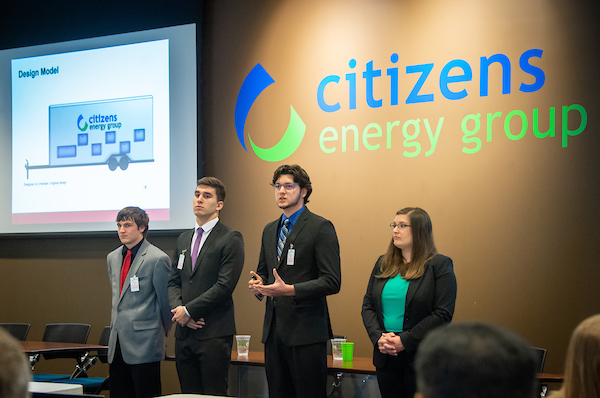
An ability to communicate effectively with a range of audiences
One of the difficult lessons that all engineers must learn is that it’s important not only to solve a problem correctly but to solve the correct problem! The most important aspect of solving the correct problem is communication. Engineering students must learn not only how to explain what they are doing, but to be able to listen to stakeholders to understand their needs. Students are taught to conduct on-site interviews as a team. Each team member has different responsibilities relating to the interview process, including engaging positively with stakeholders, and listening and watching for vocal and body language cues. Also, students are assigned to observe people in a variety of situations (e.g., on-campus, off-campus, at coffee shops, sporting events, and study areas) and to learn to carry out ethnographic observations in a systematic way to enable more human-centered designs. Naturally, engineering students also get lots of “presentation” time to share design concepts, plans, and results.
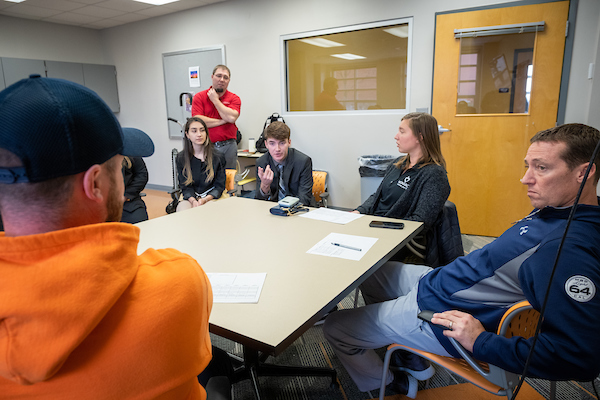
An ability to recognize ethical and professional responsibilities in engineering situations and make informed judgments, which must consider the impact of engineering solutions in global, economic, environmental, and societal contexts
A focus on ethical professional practice is a core student outcome. This outcome aligns well not only with the philosophy of ethics itself, but also with the overall goals of the Shaheen College and the University’s mission: to prepare its graduates for effective, responsible, and articulate membership in the complex societies in which they live and serve, and for excellence and leadership in their personal and professional lives. Strict adherence to ethical practice is the foundation for sound engineering decisions. It is the underlying motivation for considering all the factors discussed above.
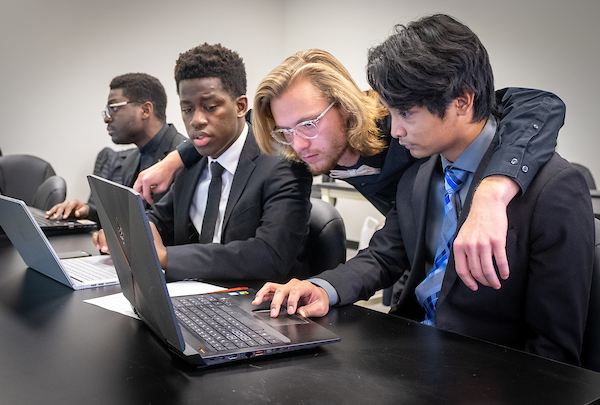
An ability to acquire and apply new knowledge as needed
This last is the essence of “learning to learn.” If we teach our students everything they need to know today but do not teach them to learn on their own, we’ve accomplished very little. This last outcome is the reason we’re here! The R.B. Annis School of Engineering, the Shaheen College of Arts and Sciences — indeed UIndy itself — can only be counted as successful if we prepare our students with this ability.
If you review these student outcomes but remove the words “engineering”, “design,” and “problem,” you’ll find most of the core principles and values of the Shaheen College. In the end, engineering is about applying these core principles to solve human problems in the world. You can’t solve human problems effectively without an understanding of human nature, human history, human expression, culture and all the rest. In this sense, it seems quite normal to find engineering among the arts and sciences. In fact, it’s a very natural home.
_______________
